Could your Diversity & Inclusion initiative benefit from DISC?
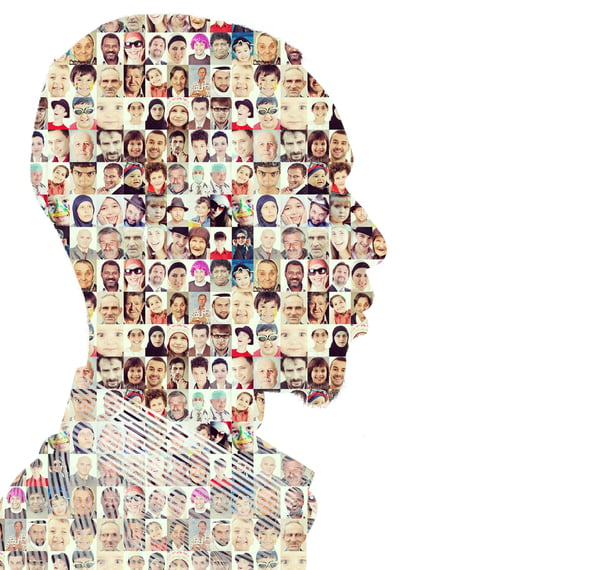 Most organizations I've worked with have some sort of diversity initiative. The name of the initiative may vary from organization to organization. I've heard Diversity, Equity, & Inclusion; Inclusive Culture; Diversity & Inclusion (D & I). What do you call it at your organization? For our purposes we'll use the language of D & I. The other thing I have noticed is that most organizations offer some sort of training around their D & I initiative. How many of you train D & I at work?
Most organizations I've worked with have some sort of diversity initiative. The name of the initiative may vary from organization to organization. I've heard Diversity, Equity, & Inclusion; Inclusive Culture; Diversity & Inclusion (D & I). What do you call it at your organization? For our purposes we'll use the language of D & I. The other thing I have noticed is that most organizations offer some sort of training around their D & I initiative. How many of you train D & I at work?
Well, 2020 just might be the year to accelerate the D & I momentum. Several states within the United States have new laws in place that address fairness. I suspect this will spark new life in D & I initiatives. So, what exactly is Diversity & Inclusion? According to an article on Built In, diversity refers to the traits and characteristics that make people unique, while inclusion refers to the behaviors and social norms that ensure people feel welcome. Let's simplify these definitions even more; Jennifer Brown, a Diversity & Inclusion expert, describes diversity as the "what" and inclusion as the "how".
As trainers we are always looking for ways to enhance our training programs. So, why not think DISC with your diversity initiatives?
Training consultants can prescribe Extended DISC® Tools
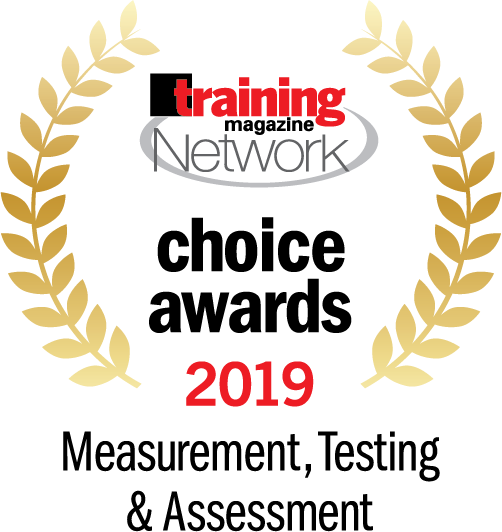
As a training consultant, I know clients don't typically come in saying "I need a DISC workshop". It's similar to going to the doctor. You don't tell the doctor, "listen, I need an x-ray". You tell the doctor what ails you and they make a recommendation. It's the same in the training world. Others come to the training department with a problem, they believe, can be solved with training. Our job as a training consultant is similar to a doctor. We need to listen, ask questions, and make a recommendation.
Extended DISC® tools can be a valid recommendation for many different "pain points" within an organization. Today, we'll focus on how Extended DISC® tools can either help revive, jump start, or enhance your Diversity & Inclusion initiative in the workplace. Plus, you don't have to wait until everyone is back in the office. You can easily deliver Extended DISC® training virtually for remote employees.
Why prescribe Extended DISC® tools?
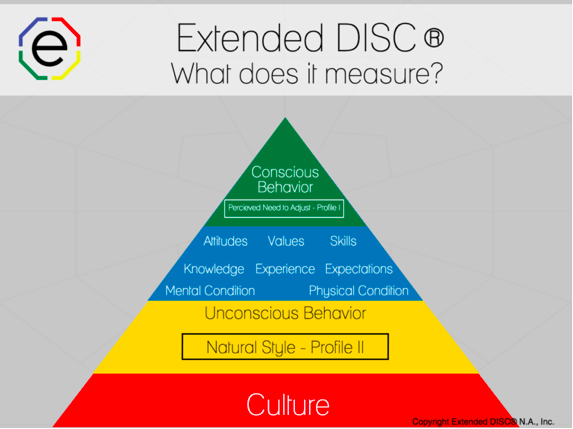
Oftentimes, the most overlooked aspect in diversity is the diversity in our unconscious behaviors. Whether we look alike or not, we are all complex, unique human beings. DISC covers the "what," our unique traits and characteristics, with the 4-quadrant DISC model. Extended DISC® also covers the "how," focusing on our unconscious behaviors, with our 4-Steps to Effective Interactions. Each step is designed to guide individuals in understanding themselves better, understanding others better, and appreciating the differences we bring to the team, or work pair, or relationship, or client interactions, etc.
So, what are the 4 Steps to Effective Interactions?

Step 1 is understanding how people are similar and different. As I mentioned, at Extended DISC® we use the 4-quadrant DISC model to help us understand those similarities and differences. We look at the 4 DISC styles in their 100% pure forms to clearly see the similarities and differences. Yet, we have all 4 styles within us. It's the particular relationship we have with the 4 styles that makes us unique.
Applying Step 1 in a diversity initiative reminds us, even if we're a homogenous group, we still have diversity in our styles. Oftentimes, the diversity that lies within our styles, is what makes interactions with others so challenging.
Step 2 is when we typically introduce the Extended DISC® assessment. Our tool is designed to measure the hard-wired DISC-style of a person. This means the results show who the individual actually is and not what the person thinks he/she needs or wants to be. DISC does not classify people into good or bad or better or worse. There are no right or wrong results. We encourage individuals to have a better understanding of themselves so they can embrace their "whole self". We don't want to change anyone. You're not broken. You don't need to be fixed. We want you to know who you are, embrace who you are, and know when to adjust your style temporarily to improve an interaction.
People love to learn about themselves. Yet, there is so much power to having this self-awareness. When we apply this knowledge in our diversity initiatives, it reminds us to bring our whole self to work. It gives us a common language to understand and appreciate our differences and similarities.
The last two steps build on our understanding of DISC styles and our self-awareness of our style in order to apply it to others.
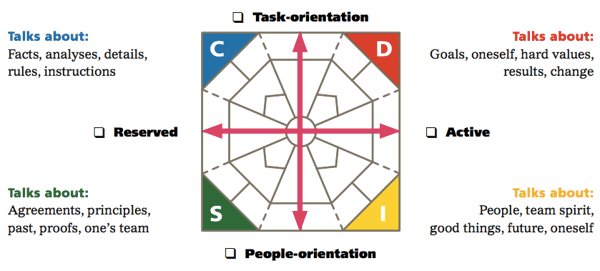 Step 3 is about identifying the DISC style of others. At Extended DISC we follow a 3-step OAR process to help us identify the style of others. First, we observe the patterns of behavior we see in the person. Next we assess which axis the behaviors fall on the DISC model. For example, does the person appear to be more task-focused or people-focused? Does the person appear more reserved or active? The last step then is to recognize which of the 4 quadrants might be the person's dominant DISC style.
Step 3 is about identifying the DISC style of others. At Extended DISC we follow a 3-step OAR process to help us identify the style of others. First, we observe the patterns of behavior we see in the person. Next we assess which axis the behaviors fall on the DISC model. For example, does the person appear to be more task-focused or people-focused? Does the person appear more reserved or active? The last step then is to recognize which of the 4 quadrants might be the person's dominant DISC style.
We don't do this to label anyone or pigeon hole them into a style. After all, we talking about diversity and inclusion. Labeling others is not our intention. Instead, we want to learn this valuable information so we will know how best to move into Step 4.
Step 4 is the application of our knowledge. How can we adjust our behaviors to interact more successfully with others?
Wait a second. Yes, you read that correctly. What can you adjust or modify? Let me ask you a question. Have you ever tried to change someone? Were you successful? We can't control or change others. The only thing we can change and control is ourselves. Ok. I know you are now thinking, wait, you told me you're not trying to change me and now you're saying I have to change? Allow me to explain.
Adjusting or modifying our behaviors refers to making temporary, brief adjustments. We are not changing who we are, we are recognizing the situation, the other person, and making an adjustment to better interact with that person. What is the cost if we don't adjust? Can we afford not to adjust? Odds are, no, we cannot.
Applying Step 4 in a diversity initiative, illustrates a mutual respect and appreciation for others. It teaches us how we can be inclusive with others so there are less misunderstandings. The perception we have of someone's behavior isn't always the other person's intention. Typically, we see the world, and others, through our own lens. DISC provides us with different lenses to view the world, and others.
Embrace who you are and embrace others just as they are.
Rather than focusing on what might frustrate us about other people; apply the Extended DISC® 4-Steps to Effective Interactions. Learn to embrace and understand who you are. Embrace others for who they are. Understand the benefits they can bring to your life, work, team, etc...The Extended DISC® tool provides us with a roadmap to help us get there. When you apply Extended DISC to your D & I initiative, you open doors for understanding how to appreciate and leverage your own strengths, and the strengths of others, for augmented success for yourself and your organization.
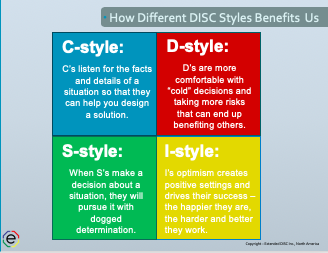
How do you use DISC with Diversity and Inclusion? We would love to hear from you!

Author: Amy Lapinskie, Senior Trainer at Extended DISC North America
